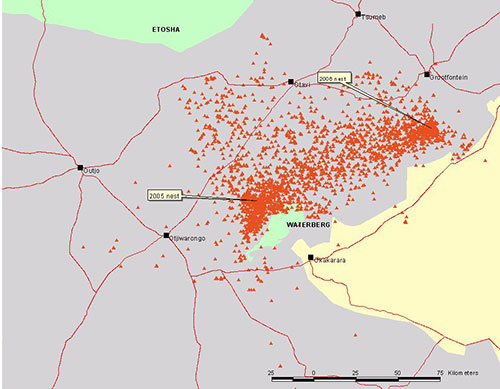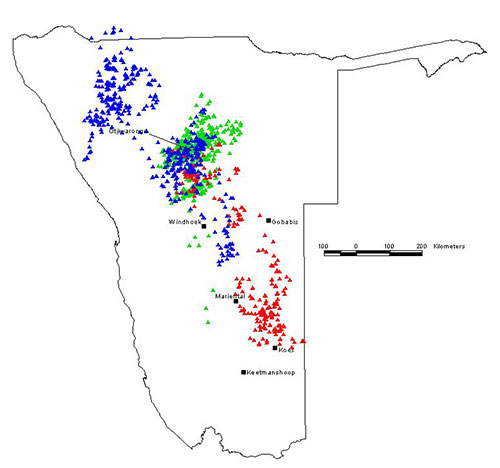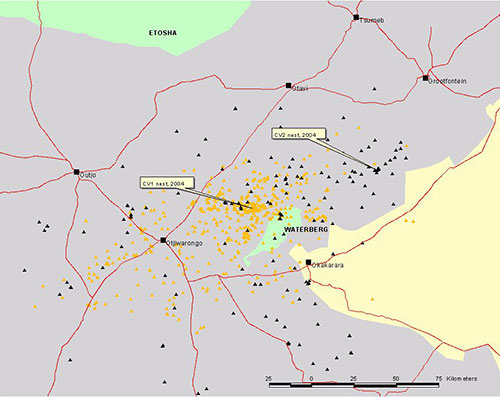Topic : Land Birds
Article 20 ![]() 31 January 2007
31 January 2007
January 2007 update on Cape Vultures fitted with satellite transmitters in Namibia
As of mid January 2007, this is what has happened to the six Cape Vultures Gyps coprotheres that are now being monitored by satellite transmitters. All the birds were caught at REST (Rare & Endangered Species Trust), 50 kilometres north-east of Otjiwarongo in Namibia. Four vultures were caught as wild birds, three being adult males (CV3, CV4 and CV5) and one as an immature female (CV6).

An adult Cape Vulture
The remaining two were released from captivity: CV7 was bred in captivity and then released at the age of 5 ½ years, while CV8 is an old adult male that had been captive for many years in South Africa (from where it came) and at REST. The grey areas in the maps consist largely of freehold farms, the yellow is mostly communal land, while the green is for national parks.

A Cape Vulture showing the typical paler coloured secondaries in flight.
The transmitters on three other birds ceased transmitting: CV1 and CV2 (both adult males) and a juvenile White-backed Vulture Gyps africanus. Together with data from these birds, a total of 42,446 locations have been recorded during this vulture tracking programme. Each of the transmitters that are now operational weighs 70 grams and is powered by a solar-charged battery.

CV3 – an adult male and the only bird to roost regularly on the Waterberg cliffs (at two sites on the western cliffs, and at one site on the eastern cliffs). The bird did not breed either in 2005 or 2006. It was caught and fitted with its transmitter on 28 November 2006 and 6,478 locations have been plotted since then. The bird often feeds at the REST vulture restaurant.

CV4 – adult male, caught and fitted with its transmitter on 28 November 2004. A total of 10,768 positions have since been recorded. Its nesting attempt in a tree near REST during 2005 was not successful. However, its 2006 nesting was probably successful since it was recorded at its nest tree between March and November. It frequently feeds at the REST vulture restaurant.

CV5 – an adult male, caught and fitted with its transmitter on 15 January 2005. A total of 8,453 locations have since been recorded. As with CV4, its 2005 attempt at breeding in a tree near REST failed, but judging from its continuous and frequent presence at its nest, the bird probably bred successfully in 2006. CV5 has spent at least 46 nights roosting on pylons supporting a 220 kilovolt electricity line. This bird and the others tracked in that area keep a wide berth around the town of Otjiwarongo, as shown clearly in this map.

CV6 – immature female, caught and fitted with its transmitter on 15 February 2005. Since then a total of 10,091 locations have been recorded. The bird has covered a sizeable area of southern Africa, having been in six countries. The straight line distances covered from point to point (these are recorded each hour) indicate that CV6 has flown at least 64,000 kilometres. These distances do not include circling and meanders flown between each hourly location. While many of its movements appear nomadic, what is interesting is that CV6 has repeatedly returned to several, perhaps favoured foraging areas. These are in western Omusati (roughly south of Ruacana), where it spent several weeks at a stretch in each of March, May, July and December 2005-January 2006.
Likewise, it spent several weeks in northern Botswana and Caprivi (mainly around the Panhandle of the Okavango Delta and in the Linyanti area) in July-September 2005 and again in August-September 2006. Lastly, it has spent time in south-eastern Namibia on three separate occasions: October-November 2005, April-July 2006, and December 2006-January 2007. Other favoured foraging areas have been in south-eastern Botswana and to the west and east of Okaukuejo along the Etosha salt pan. Interestingly, while in south-eastern Namibia it has only once crossed (and for only an hour) into the nearby Kgalagadi National and Transfrontier Park, suggesting that much more food is available on the Namibian farmlands.

CV7 (green dots) - young captive bred female, released on 22 October 2005. A total of 1,624 locations have been received. The bird remained within 5 kilometres of its release site at REST for about three and a half months. Then, on 7 February 2006, it took off and has been wandering around ever since, but also returned frequently to hang around the Diekmann’s house and the REST vulture restaurant a few hundred metres away. Just recently in early January 2007, it appears to have finally ‘left home’ and moved into southern Namibia.
CV8 (red dots) – also a captive bird that was released on 28 August 2006. A total of 554 locations have been recorded (co-ordinates from this bird and CV7 are only recorded every two hours, unlike the hourly records received for the other vultures). CV7 hung around its release site and home (over the past several years) at REST for about 10 days, and then headed off. It remained foraging over a large area south of Otjiwarongo until early November, when it moved to south-eastern Namibia. This is the same area that has been favoured by CV6.
WBV (black dots) – this juvenile was an enigma. After capture at REST and being examined in the hand, the bird appeared to several observers to be not quite a White-backed Vulture, almost edging towards looking like a Cape Vulture. To support the wild idea that this could be a hybrid, recorded co-ordinates showed that the young bird frequently roosted in the tree nest of CV1, suggesting that CV1 could be its parent and while the parent was perhaps a White-backed. The young bird remained around in a broad zone near its possible nest until early May 2004. It then took off for north-western Namibia and a brief sortie into Angola. It later returned south, spending a good deal of time south of Otjiwarongo. Sadly, the bird was found in a weak state and later died, perhaps of poisoning. A total of 1,600 locations were reported between 21 March and 19 September 2004.

CV1 (orange dots) and CV2 (black) were both adult males that apparently nested in trees in 2004. Their transmitters ceased functioning or fell off, and they were therefore only tracked for a relatively short period (CV1: from 21 March to 31 October 2004, giving 2,224 co-ordinates; CV2: from 21 March to 17 May 2004, with 654 records). The movements and ranges of these two birds was very similar to those of the other three wild adults (CV3, 4 and 5). What is perhaps most noteworthy is the lack of foraging by all the birds over either the nearby communal land to the east or southern Etosha to the north. Most birds have also avoided foraging over the Waterberg Plateau Park.
